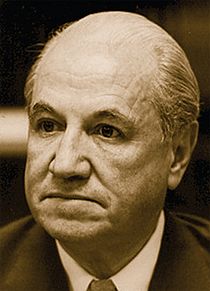Raúl Prebisch facts for kids
Quick facts for kids
Raúl Prebisch
|
|
|---|---|
 |
|
| Born | April 17, 1901 San Miguel de Tucumán, Argentina
|
| Died | April 29, 1986 (aged 85) Santiago de Chile, Chile
|
| Field | Development economics |
| School or tradition |
Structuralist economics |
| Alma mater | University of Buenos Aires |
| Contributions | Singer–Prebisch thesis |
Raúl Prebisch (April 17, 1901 – April 29, 1986) was an important Argentine economist. He is famous for his ideas about how countries develop their economies. He helped create a way of thinking called structuralist economics. One of his main ideas is known as the Prebisch–Singer hypothesis. This idea helped form the basis of dependency theory, which looks at why some countries stay poor.
In 1950, he became the head of the Economic Commission for Latin America (ECLA or CEPAL). That same year, he wrote a very important study called The Economic Development of Latin America and its Principal Problems.
Contents
Early Life and Changing Ideas
Raúl Prebisch was born in Tucumán, Argentina. His family were German settlers. He studied at the University of Buenos Aires and later taught there. His brother, Alberto Prebisch, became a famous architect.
When he was young, Prebisch strongly believed in free-trade. This means countries could trade freely without many rules. Argentina had grown a lot from the 1860s to the 1920s by selling beef and wheat to the United Kingdom.
However, things changed in the 1930s during the Great Depression. This was a time when the world economy was very bad. Argentina's economy was hurt because the United States started selling beef and wheat instead of buying them. This made Prebisch change his mind. He then believed in protectionism, which means a country protects its own industries by adding taxes to imported goods.
Understanding the World Economy: Centre and Periphery
Argentina's problems made Prebisch think differently about economics. He looked at the idea of comparative advantage, which was developed by David Ricardo. This idea says countries should make what they are best at.
Prebisch started a new way of thinking in the late 1940s. He divided the world into two parts:
- The centre: These are industrial countries like the U.S. They make manufactured goods.
- The periphery: These are countries that mainly produce raw materials, like farm products.
As the head of the Central Bank of Argentina, Prebisch noticed something during the Great Depression. The prices of raw materials (like food) fell much more than the prices of manufactured goods. He and his team thought this was because farmers kept growing the same amount of crops, no matter the price. But factories could make fewer goods if demand was low.
The Prebisch–Singer Hypothesis
These ideas became clearer when Prebisch became the head of the Economic Commission for Latin America (ECLA) in 1950. He wrote his important study, The Economic Development of Latin America and its Principal Problems. This study explained what is now called the Prebisch–Singer hypothesis.
Another economist, Hans Singer, came up with a similar idea around the same time. The hypothesis says:
- Poor countries (the periphery) sell raw materials to rich countries (the centre).
- Rich countries (the centre) sell manufactured goods to poor countries.
As technology gets better, rich countries keep the benefits. They can pay higher wages and make more profit. But in poor countries, companies and workers are weaker. They have to lower their prices when technology improves. This means poor countries have to sell more of their raw materials to buy the same amount of manufactured goods. Prebisch called this a decline in the terms of trade. He believed that all the benefits of new technology and international trade would go to the rich countries.
Because of Prebisch's influence, ECLA became a key place for developing countries to work together. This led to the Latin American school of structuralist economics. Many people thought Prebisch supported import substitution industrialization (ISI). This is when a country tries to make its own goods instead of importing them. However, Prebisch later criticized protectionism and ISI. He believed developing countries should industrialize and trade more with each other.
In 1977, the International Institute of Social Studies (ISS) honored Raúl Prebisch.
Leading UNCTAD
From 1964 to 1969, Prebisch was the first secretary-general of the United Nations Conference on Trade and Development (UNCTAD). He was chosen because of his great reputation. He wanted UNCTAD to speak for all developing countries.
He focused on trade, suggesting that rich countries should give special access to their markets for goods from developing countries. He also pushed for countries in the periphery to trade more with each other. He increasingly believed that developing countries needed to make their own internal changes to grow, rather than just relying on outside help. He even said that ISI had not worked well.
Prebisch found his time at UNCTAD difficult. He felt it became too focused on rules and did not achieve its goals. He resigned in 1969 because he lost patience with the organization's problems.
Dependency Theory
In the 1960s, economists at the United Nations Economic Commission for Latin America and the Caribbean (ECLA) built on Prebisch's ideas. They developed dependency theory. This theory suggests that it is very hard for poor countries to develop their economies because they depend on rich countries.
Even though dependency theory went further than Prebisch's original ideas, he continued to criticize the economic forces that he felt were hurting poor countries around the world.
Legacy
Before the Augusto Pinochet government took over in Chile, Prebisch's ideas were very important in the country, especially at the University of Chile.
Works
- Raúl Prebisch, The Economic Development of Latin America and Its Principal Problems (New York: United Nations, 1950)
See also
 In Spanish: Raúl Prébisch para niños
In Spanish: Raúl Prébisch para niños
- Import substitution industrialization
- Unequal exchange
- Samir Amin
- Celso Furtado
- Fair trade

